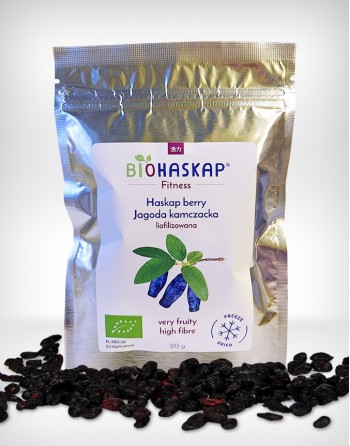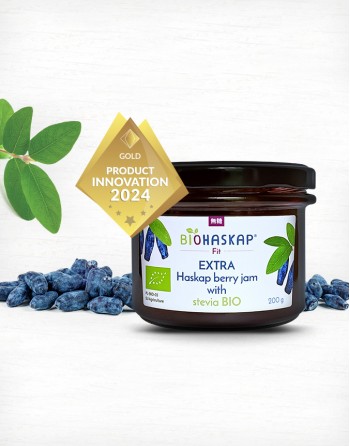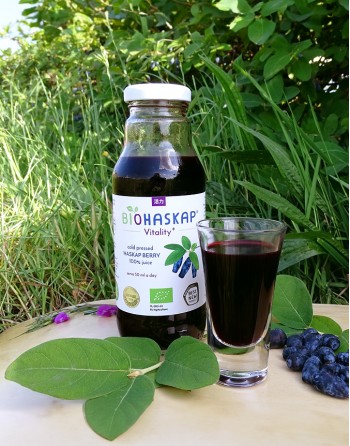About haskap

Haskap is a fruit bush originating from Kamchatka, and is also known as blue berry honey suckle (Lonicera caerulea). It has been highly regarded for its pro-health properties in Japan for decades, cultivated in Canada for 10 years and on an industrial scale in Poland for a few years. The bushes, thanks to their origin, are resistant to varying and challenging climate conditions, and cope especially well with spring frost. They are long-life plants, even living up to 40 years and still giving fruits.
Haskap starts vegetation very early, even in March. By April it is blooming in full, with white, long flowers collected in bunches, from which fruits develope at the end of May and beginning of June. The harvest takes about 2 weeks. Berries are longitudinal, oval, blue with velvet skin, and have a very rich sweet and sour flavour combining notes of blueberry, blackberry, blackcurrant and raspberry. This is an unusual fusion unprecedented in other fruits.


The berries in their fresh state have the best taste, but making juice or jam allows them to be enjoyed for longer, or they can be frozen and used for making delicious milk-based smoothies or cocktails for a whole year.
Haskap fruits are very rich in bioactive compounds, polyphenols such us: anthocyanins -majority cyanidin-3-O-glucoside, phenolic acids - majority chlorogenic acid, flavonols and flavons -majority luteolin, quercetin, and catechins. In spite of this, iridoids, very rarely present in fruits, have also been recently found in the berries.
They are a source of vitamin C, provitamins: A, B1, B2, B6, B9, P and minerals: calcium, magnesium, potassium.
The most valuable bioactive substances that are contained in berries are polyphenolics, more specifically anthocyanins – a pigment that gives them their black colour. The anthocyanins content in haskap fruits is several times higher than in vegetables or well-known fruits and reaches in Polish cultivars from 1240 to 3510 mg on 100 g of fresh berries.
Many studies prove that anthocyanins have a much higher antioxidant potential than more well‑known reference antioxidants such us vit. E, β‑karoten or vit. C. Their free radicals removal activity is much potentiated by accompanying iridoids.
The consumption of food rich in anthocyanins is connected with a lower mortality rate from civilization diseases.Those compounds act as an antiatherogenic, lower oxidative stress, remove free radicals and mitigate the side effects of chemotherapy.

In the language of the Ainu people, haskap was called a berry of long life and good sight, because the substances it contains have positive effect on visual acuity, vision after dark and light inflamation of the eye.
Fruits and flowers have anti-inflammatory, anti-bacterial and anti-viral properties, and their infusions are used for pharyngitis treatment in Russia.
Therefore the food products made of haskap fruits can be classified as nutraceticals: are not a medicine, but given oraly are a source of bioactive compounds that have health benefits. Lonicera caerulea (blue honeysuckle, haskap) is on the Canadian Health Ministry list of Natural Health Products as a new berry crop with high antioxidant capacity.
Source: Lila M.A. Anthocyanins and human health: An in vitro investigative approach. J. Biomed. Biotechnol. 2004, 5: 306 – 313 14, Miguel MG: Anthocyanins: Antioxidant and/or anti-inflammatory activities. Journal of Applied Pharmaceutical Science 01 (06), 2011, 07-15; Clifford M.N.: Anthocyanins - nature, occurrence and dietary burden. J. Sci. Food Agric., 2000; 80: 1063-1072; Grajek W.: 2004. Rola przeciwutleniaczy w zmniejszaniu ryzyka wystąpienia nowotworów i chorób układu krążenia. Żywność. Nauka. Technologia. Jakość, 1 (38), 3-11.; Piasek A.: 2010.Badanie zmian składu fitokompleksu i właściwości przeciwutleniających owoców aronii czarnoowocowej (Aronia melanocarpa (Michx.) Elliott) i wiciokrzewu sinego (Lonicera caerulea L.) pod wpływem przetwarzania. Rozprawa doktorska, Gdańsk, 6–40; Szot I., Lipa T., Sosnowska B.: 2014. Jagoda kamczacka – właściwości prozdrowotne owoców i możliwości ich zastosowania. Żywność. Nauka. Technologia. Jakość, 4 (95), 18 – 29; 14, 22.
There are 6 products.
Extra Haskap berry jam with BIO stevia, BIOHASKAP ® Fit, 200g
Delicious sour flavor of haskap berry balanced with the slight sweetness of stevia:
BIO haskap berry is up to 99%, 428 g of fruits were used to make 200g of jam
BIO stevia 0.32%
For those limiting sugar in their diet
Natural sugar content only 12g/100g of product
No concentrated apple juice added!
High anthocyanin content: 270 mg/100g, in one teaspoon there are 41 mg of anthocyanins
Organic haskap berry powder BIOHASKAP ® Regeneration+, 50g, anthocyanins & iron source
Anthocyanin supplement 2300mg/100g
Natural iron source, contributes to:
- reduction of tiredness and fatigue
- normal function of the immune system
- normal oxygen transport in the body & red blood cells and haemoglobin formation
1 teaspoon (3,5g) = 80mg anthocyanins = equivalent of 320 mg of vit. C
100% natural fruit powder
Ideal for vegans, vegetarians, sportsmen
ORDER 2 FOR FREE DELIVERY!
4 x 300 ML haskap berry organic juice BIOHASKAP ® Vitality. Potassium source.Best New Product BIOFACH 2019
100 % organic haskap berry juice
NUTRACEUTIC: Potassium source, helps to maintain normal blood pressure.
50 ml daily
1 bottle 300 ml = 6 portions 50 ml
FREE DELIVERY
10,99 €/ bottle
Deep ruby color, sweet & sour
BEST NEW PRODUCT AWARD BIOFACH 2019






